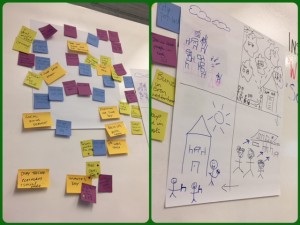What is Design Thinking?
By Alex andra Rodney, Student Innovation Leader, Operations Team
andra Rodney, Student Innovation Leader, Operations Team
In September I introduced you to the Innovation Hub project and explained how we are working on developing innovative solutions to improve the student experience at the University of Toronto. In this post I’ll describe the method we are using to innovate. At the Innovation Hub we are using a “design thinking” approach. This approach has its roots at IDEO, David Kelley’s global design firm, where techniques used to design products were applied to the design of organizational operations and services. You may not have heard of IDEO but you’ve likely been in contact with their design innovations. Among other things that IDEO has patents on are the Apple mouse, laptop computer hinges, and the stand-up toothpaste bottle.
Stand-up toothpaste bottle
Design thinking is a human-centered approach to solving problems. At the Innovation Hub our approach will be student-centered. What do we mean by student-centered? To answer this question we have to think about traditional problem-solving processes in organizations. Great ideas sit at the intersection of feasibility, desirability and viability (organizations have the capability to produce them, people want them and they are financially possible to sustain). When designing products or solutions, most organizations start with thinking about feasibility and viability. A design thinking approach turns that traditional process on its head and starts with desirability. Designers use a deep empathic process of observing and interviewing people to understand what they truly want and need. Design thinking pushes up against our natural tendencies to get straight to problem solving and forces designers to be comfortable listening to people and not having the answers to their problems immediately. A design thinking approach start with the people we are designing for so that the solutions we come up with are sure to meet their needs. At the Innovation Hub we are positioning students as the experts of their own lives. By learning about their lives we can begin to design a spectacular student experience.
As part of our work at the Hub we have had the opportunity to receive design thinking training from Toronto experts in the field. The entire team took a Design Thinking for Innovation workshop with i-Think’s Nogah Kornberg and a few of us (including myself!) had the opportunity to participate in Experience Point’s Experience Innovation workshop. At both of these training sessions we had the opportunity to engage in the work of all three design thinking phases: inspiration, ideation and implementation. At the Innovation Hub we are currently wrapping up the inspiration phase. The inspiration phase involved immersing ourselves in the student experience. The five domain teams have been observing students on campus and interviewing them in a way that captures deep insights about their lives. The second phase is ideation, and teams will begin this in late November. Ideation involves making sense of what we learned in the inspiration phase. We will identity student needs, opportunities for problem-solving and design prototype solutions. Implementation is the final phase in the design thinking process. It is at this point that proposed solutions get brought to life. Here is where teams will turn their prototype concepts into something real, determine how they are going to define success, pilot their projects as well as assess and evaluate them.
Ideating at the ExperiencePoint Experience Innovation workshop
At its heart, all social research has key components that are reflected in design thinking terminology. Those of you who are anthropologists or sociologists might recognize design thinking as a distilled version of ethnography. Are the building blocks of design thinking similar to the research terminology used in your field? Are you interested in learning more about the Innovation Hub and our research activities? The Innovation Hub is a collaborative process open to all members of the UofT community. Stay tuned to our events page for upcoming Innovation Hours and keep up-to-date with our progress by subscribing to our blog posts (right there on the right-hand side of this page –>).


0 comments on “What is Design Thinking?”